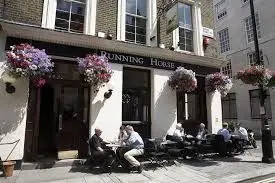THE RUNNING HORSES - Mickleham
Over 200 views on venues4hire.org

THE RUNNING HORSES - THE RUNNING HORSES
To make a booking or enquire about hiring this venue please use the contact details below - Please mention Venues for Hire
01372 372279
Bookings Administrator
Use contact form below
THE RUNNING HORSES description
Pub / Restaurant
Medium (1-150)
The Running Horses stands on Old London Road, at the centre of pretty Mickleham village. Opposite, is the ancient church of St Michael, which is mentioned in the Domesday book. We’re surrounded by history and we have a few fascinating tales of our own to tell.
Most people agree that the inn was built in the 16th century. Architectural historians discovered original brickwork features that can still be seen in the cellar. It’s thought the land it stands on may once have been part of Mickleham Manor. The house first belonged to Thomas Stydolf who died in 1546, and whose family owned much of the surrounding countryside.
Following improvements in 1755, Old London Road became the main route from London to Brighton. The Running Horses had an important role as a coaching inn and post house. Merchants and gentry, taking advantage of the fast new road, would have mingled in the inn’s bars and restaurant. However, characters of more unsavoury kind would have found the road a prime business route too. Highwaymen were the scourge of 16th century travellers and a tiny ladder leading to the roof space was discovered when the bedrooms were added, and it was thought to be a highwayman’s escape route.
The Racing Connection
In the days before rail travel, the inn was a favourite stabling for horses racing at Epsom. And up until recently, there were training gallops on Mickleham Downs. At one point in its history, the inn was called The Chequers. It was renamed The Running Horses in 1828 because of a famous incident at the Epsom Derby of that year. Two horses, Colonel and Cadland both passed the post at exactly the same moment and the race became known as the ‘Dead Heat Derby’. You’ll see portraits of Colonel and Cadland, one on each side of the inn’s sign, and each of our two bars is named after them.
Famous people in Mickleham
James Mill and his son John Stuart Mill, the famous philosopher and civil servant, lived for a time in a house behind The Running Horses.
Richard Bedford Bennett, Canadian prime minister from 1930 to 1935, retired to Mickleham. He is buried in St. Michael’s Churchyard: the only former Canadian prime minister not to be buried in his country.
Mystery writer and county court judge, Cyril Hare 1900-1958 was born in Mickleham. Christened Alfred Alexander Gordon Clarke, he wrote a small number of detective novels. ‘Tragedy at Law’ is the best known.
St Michael’s Church
A church has stood on this site for over a thousand years. The original church was a small Saxon building, which is mentioned in the Domesday Book (1080-1086). The entry states: ‘There is a Church and two acres of meadow’.
You can still see traces of this ancient building if you look up over the main door once you are inside, which is thought to date back to 950. Most of the building you see today is Norman and dates from around 1180, however it underwent re-construction in 1842. The work included taking down the old west end of the nave and revealed the old plaster coating which bore the date 1080 marked in red.
We’d love to know more about the history of The Running Horses and Mickleham, so, if you have any info, stories, or photographs please do let us know.
Most people agree that the inn was built in the 16th century. Architectural historians discovered original brickwork features that can still be seen in the cellar. It’s thought the land it stands on may once have been part of Mickleham Manor. The house first belonged to Thomas Stydolf who died in 1546, and whose family owned much of the surrounding countryside.
Following improvements in 1755, Old London Road became the main route from London to Brighton. The Running Horses had an important role as a coaching inn and post house. Merchants and gentry, taking advantage of the fast new road, would have mingled in the inn’s bars and restaurant. However, characters of more unsavoury kind would have found the road a prime business route too. Highwaymen were the scourge of 16th century travellers and a tiny ladder leading to the roof space was discovered when the bedrooms were added, and it was thought to be a highwayman’s escape route.
The Racing Connection
In the days before rail travel, the inn was a favourite stabling for horses racing at Epsom. And up until recently, there were training gallops on Mickleham Downs. At one point in its history, the inn was called The Chequers. It was renamed The Running Horses in 1828 because of a famous incident at the Epsom Derby of that year. Two horses, Colonel and Cadland both passed the post at exactly the same moment and the race became known as the ‘Dead Heat Derby’. You’ll see portraits of Colonel and Cadland, one on each side of the inn’s sign, and each of our two bars is named after them.
Famous people in Mickleham
James Mill and his son John Stuart Mill, the famous philosopher and civil servant, lived for a time in a house behind The Running Horses.
Richard Bedford Bennett, Canadian prime minister from 1930 to 1935, retired to Mickleham. He is buried in St. Michael’s Churchyard: the only former Canadian prime minister not to be buried in his country.
Mystery writer and county court judge, Cyril Hare 1900-1958 was born in Mickleham. Christened Alfred Alexander Gordon Clarke, he wrote a small number of detective novels. ‘Tragedy at Law’ is the best known.
St Michael’s Church
A church has stood on this site for over a thousand years. The original church was a small Saxon building, which is mentioned in the Domesday Book (1080-1086). The entry states: ‘There is a Church and two acres of meadow’.
You can still see traces of this ancient building if you look up over the main door once you are inside, which is thought to date back to 950. Most of the building you see today is Norman and dates from around 1180, however it underwent re-construction in 1842. The work included taking down the old west end of the nave and revealed the old plaster coating which bore the date 1080 marked in red.
We’d love to know more about the history of The Running Horses and Mickleham, so, if you have any info, stories, or photographs please do let us know.
Venue suitability
This venue is suitable for the following uses:
Venue facilities
Other venue facilities
We don't currently hold any detailed information about the rooms at this Venue.
If this is your Venue or Hall please use the Adopt link on the right to add more detailed information about this Venue.
If you wish to hire this Venue or Hall please use the contact details on the overview tab.
Please encourage every Venue to take a few minutes to 'Adopt' their listing and add unique content and photos.
